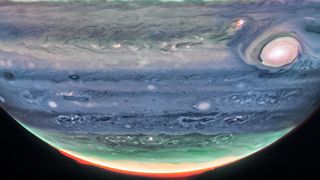News
Science & Astronomy

Researchers using NASA’s James Webb Space Telescope’s NIRCam (Near-Infrared Camera) have discovered a high-speed jet stream sitting over Jupiter’s equator, above the main cloud decks. At a wavelength of 2.12 microns, which observes between altitudes of about 12-21 miles (20-35 kilometers) above Jupiter’s cloud tops, researchers spotted several wind shears, or areas where wind speeds change with height or with distance, which enabled them to track the jet.
(Image credit: NASA, ESA, CSA, STScI, Ricardo Hueso (UPV), Imke de Pater (UC Berkeley), Thierry Fouchet (Observatory of Paris), Leigh Fletcher (University of Leicester), Michael H. Wong (UC Berkeley), Joseph DePasquale (STScI))
Though NASA’s James Webb Space Telescope (JWST) was initially touted as having the power to unveil our universe’s furthest horizons — and it surely has — some of the observatory’s most gorgeous images are actually ones of our very own solar system.
With its gold-plated hive of mirrors and backpack of infrared equipment, such as the Near-Infrared Camera (NIRCam), the James Webb Space Telescope has reintroduced us to the stunning place we call home, making us feel like we’re seeing our planetary neighbors for the first time all over again. It even offered us a poignant view of Neptune’s frail rings, something that hasn’t been done for 30 years.
But on Thursday (Oct. 19), scientists announced that, beyond offering us fresh eyes on the solar system, the JWST’s images of our cosmic neighborhood are also presenting us with new data about a planet we thought we knew quite well: Jupiter.
Images the observatory took of the gas giant last year have managed to show us brand new things about its moons, atmosphere and rings. (Yes, Jupiter has rings too!) Basically, after examining images the JWST captured of Jupiter in 2022, a team of researchers realized there’s a high-speed jet stream on the planet that’s more than 3,000 miles (4,800 kilometers) wide and traveling at about 320 mph (515 kph.) This is something that has never been seen before.
“That totally surprised us,” Ricardo Hueso of the University of the Basque Country in Bilbao, Spain and lead author on a paper describing the findings, said in a statement.
Related: James Webb Space Telescope detects 1st evidence of carbon on Jupiter’s icy moon Europa
“It’s amazing to me that, after years of tracking Jupiter’s clouds and winds from numerous observatories, we still have more to learn,” Leigh Fletcher of the University of Leicester in the United Kingdom, a member of the new study, said in the statement.
What could this mean?
According to the team, this newfound jet stream on Jupiter — that’s blasting away at about twice the speed of a Category 5 hurricane on Earth and sits right above the equator — might shed some light on the planet’s turbulent atmosphere. In fact, all of those 2022 Jupiter images might help researchers deduce what goes on in the skies of the apricot-striped orb.
“What we have always seen as blurred hazes in Jupiter’s atmosphere now appear as crisp features that we can track along with the planet’s fast rotation,” Hueso said.
Jupiter is notorious for its extreme weather; you might’ve heard of Jupiter’s Great Red Spot, for instance, which is a never-ending, enormous storm that’s so huge it’s visible from our vantage point on Earth with a regular old optical telescope. And, importantly for science investigations, Jupiter’s atmosphere is layered, like Earth’s. This means wind speeds in different layers are probably contributing to the giant planet’s tumultuous climate.
It’s also why Hueso and fellow researchers hope to compare what the JWST’s infrared vision has seen among Jupiter’s high-altitude atmospheric layers — which revealed the new jet stream via some cloud-related features — with what the Hubble Space Telescope has already seen in deeper layers. Hopefully, that’ll give us a pretty clear picture of those wild Jovian winds.

Researchers using NASA’s James Webb Space Telescope’s NIRCam (Near-Infrared Camera) have discovered a high-speed jet stream sitting over Jupiter’s equator, above the main cloud decks. At a wavelength of 2.12 microns, which observes between altitudes of about 12-21 miles (20-35 kilometers) above Jupiter’s cloud tops, researchers spotted several wind shears, or areas where wind speeds change with height or with distance, which enabled them to track the jet. (Image credit: NASA, ESA, CSA, STScI, Ricardo Hueso (UPV), Imke de Pater (UC Berkeley), Thierry Fouchet (Observatory of Paris), Leigh Fletcher (University of Leicester), Michael H. Wong (UC Berkeley), Joseph DePasquale (STScI))
In fact, Hubble images — which are primarily associated with the visible and ultraviolet parts of the electromagnetic spectrum — have already helped out, offering information about what the area around Jupiter’s equator usually looks like (so the team could have a baseline before studying JWST’s equatorial jet stream data) and regarding other storms in the region unrelated to the jet.
“We knew the different wavelengths of Webb and Hubble would reveal the three-dimensional structure of storm clouds, but we were also able to use the timing of the data to see how rapidly storms develop,” Michael Wong of the University of California, Berkeley, who led the associated Hubble observations and was a member of the new study, said in the statement.
In other words, the team explains, that comparison could help us understand how wind speeds on Jupiter change with altitude and generate what are known as “wind shears,” which are kind of like wind speed gradients over short distances. The extremely fast jet itself is located about 25 miles (40 kilometers) above the planet’s cloud tops, so if lower winds exhibit much lower speeds, wind shears are likely the result.
“Jupiter has a complicated but repeatable pattern of winds and temperatures in its equatorial stratosphere, high above the winds in the clouds and hazes measured at these wavelengths,” Fletcher said. “If the strength of this new jet is connected to this oscillating stratospheric pattern, we might expect the jet to vary considerably over the next two to four years.
“It’ll be really exciting to test this theory in the years to come.”
The paper was published on Thursday (Oct. 19) in the journal Nature Astronomy.
Join our Space Forums to keep talking space on the latest missions, night sky and more! And if you have a news tip, correction or comment, let us know at: [email protected].
Breaking space news, the latest updates on rocket launches, skywatching events and more!
Monisha Ravisetti is Space.com’s Astronomy Editor. She covers black holes, star explosions, gravitational waves, exoplanet discoveries and other enigmas hidden across the fabric of space and time. Previously, she was a science writer at CNET, and before that, reported for The Academic Times. Prior to becoming a writer, she was an immunology researcher at Weill Cornell Medical Center in New York. She graduated from New York University in 2018 with a B.A. in philosophy, physics and chemistry. She spends too much time playing online chess. Her favorite planet is Earth.
>>> Read full article>>>
Copyright for syndicated content belongs to the linked Source : Space.com – https://www.space.com/james-webb-space-telescope-jupiter-jet-stream-photo































